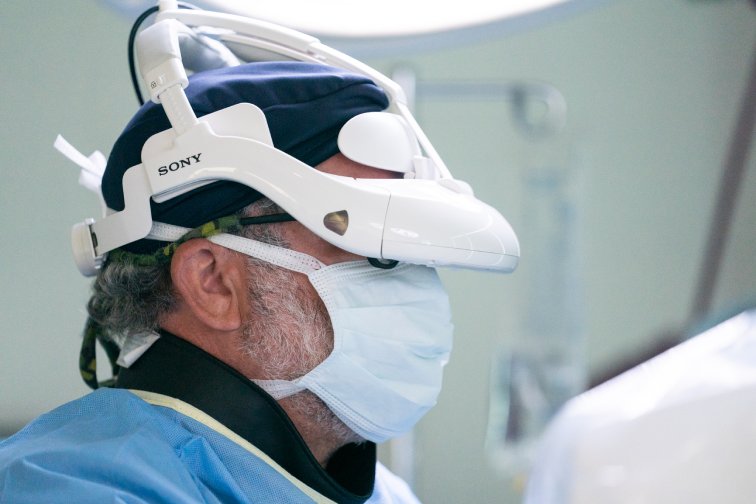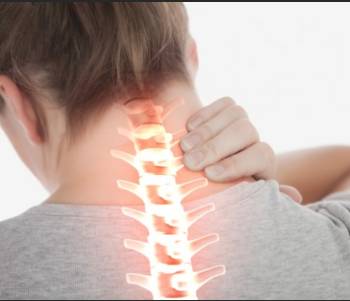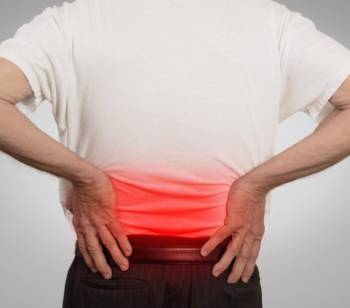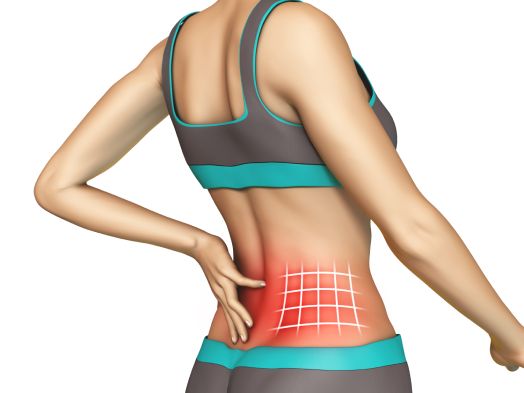Endoscopic Anterior Cervical Discectomy
Endoscopic anterior cervical discectomy is a form of spine surgery used to treat patients suffering from neck pain or spinal nerve pain (cervical radiculopathy) due to a cervical disc herniation. The procedure is performed through a band-aid incision. The herniated disc is removed with micro-instruments using an endoscope, high resolution HD video and a heads-up surgical display. This minimally invasive hi-tech procedure avoids injury to normal portions of the disc and maintains normal spinal strength and stability. This is an out-patient procedure where patients return home the same day. A rapid recovery is expected and patients start to resume activity the next day.
Endoscopic Posterior Cervical Discectomy
Endoscopic posterior discectomy is a minimally invasive procedure used to treat patients with neck pain and spinal nerve pain (cervical radiculopathy) due to some forms of cervical disc herniation. The procedure can also be used to treat cervical radiculopathy caused by a form of spinal degeneration called stenosis. Endoscopic posterior discectomy is performed through a band-aid incision. The herniated disc is removed with micro-instruments using an endoscope, high resolution HD video and a heads-up surgical display. This minimally invasive hi-tech procedure avoids injury to normal portions of the disc and maintains normal spinal strength and stability. This is an out-patient procedure where patients return home the same day. A rapid recovery is expected and patients start to resume activity the next day.
Endoscopic Cervical Facet Debridement
Endoscopic cervical facet debridement is a minimally invasive procedure that is used for patients with neck pain and headaches coming from the cervical facet joints. The cervical facet joint is a paired joint on either side of the disc. Cervical facet pain can be seen with degeneration or whiplash injury. Endoscopic cervical facet debridement is performed through a band-aid incision. The painful facet joint is treated with micro-instruments using an endoscope, high resolution HD video and a heads-up surgical display. Treatment consists of releasing the painful joint capsule and injured tissue within the joint. The surgeon will also coagulate the nerve endings within the painful joint capsule, relieving pain sensation. Unlike other treatments for cervical facet pain, this minimally invasive hi-tech procedure can provide a cure without resulting to spinal fusion. This is an out-patient procedure where patients return home the same day. A rapid recovery is expected and patients start to resume activity the next day.
Endoscopic Thoracic Transforaminal Discectomy
Endoscopic thoracic discectomy is a minimally invasive procedure that is used for the treatment of upper back pain and nerve pain (radiculopathy) due to disc herniations of the thoracic spine. The procedure is performed through a band-aid incision. The herniated disc is removed with micro-instruments using an endoscope, high-resolution HD video and a heads-up surgical display. This minimally invasive hi-tech procedure avoids injury to normal portions of the disc and maintains normal spinal strength and stability. Endoscopic thoracic discectomy is one of the few ways to treat a thoracic disc herniation without performing open chest surgery. This is an out-patient procedure where patients return home the same day. A rapid recovery is expected and patients start to resume activity the next day.
Endoscopic Thoracic Laminotomy
Endoscopic thoracic laminotomy is a minimally invasive procedure used to treat patients suffering from nerve and spinal cord compression due to spinal stenosis. This compression results in conditions known as thoracic radiculopathy and myelopathy. This procedure is performed through a band-aid incision. Micro-instruments, an endoscope, high-resolution HD video and a heads-up surgical display are used to remove overgrown and degenerated bone and ligaments that are compressing neurological structures. Injury to normal structures is minimalized and patients return home the same day. A rapid recovery is expected and patients can begin light activity the next day.
Endoscopic Thoracic Facet Debridement
Endoscopic thoracic facet debridement is a minimally invasive endoscopic procedure used to treat patients with upper back pain originating from the thoracic facet joints. The procedure is performed through a band-aid incision. Micro-instruments, an endoscope, high resolution HD video and a heads-up surgical display are used to visualize the injured thoracic facet joint. The facet joint capsule is incised, relieving strain. The facet joint is then inspected for torn or injured joint components that may be causing pain with motion of the upper back. This minimally invasive procedure is performed with minimal disruption to normal muscles and ligaments of the thoracic spine. As a result, patient's return home the same day. A rapid recovery is expected and light activity can begin on the following day.
Endoscopic Transforaminal Lumbar Discectomy
Endoscopic transforaminal lumbar discectomy is a minimally invasive procedure that is used for the treatment of low back pain and nerve pain (sciatica or lumbar radiculopathy) due to a lumbar herniated disc. The procedure is performed through a band-aid incision. The herniated disc is removed with micro-instruments using an endoscope, high resolution HD video and a heads-up surgical display. This minimally invasive hi-tech procedure avoids injury to normal portions of the disc and maintains normal spinal strength and stability. In many cases, endoscopic transforaminal lumbar discectomy may be performed instead of a lumbar fusion. This is an out-patient procedure where patients return home the same day. A rapid recovery is expected and patients start to resume activity the next day.
Endoscopic Interlaminar Lumbar Discectomy
Endoscopic interlaminar lumbar discectomy is a minimally invasive procedure that is used for the treatment of low back pain and nerve pain (sciatica or lumbar radiculopathy) due to a lumbar herniated disc. The procedure is performed through a band-aid incision. The herniated disc is removed with micro-instruments using an endoscope, high resolution HD video and a heads-up surgical display. This minimally invasive hi-tech procedure avoids injury to normal portions of the disc and maintains normal spinal strength and stability. In many cases, endoscopic interlaminar lumbar discectomy may be performed instead of a lumbar fusion. This is an out-patient procedure where patients return home the same day. A rapid recovery is expected and patients start to resume activity the next day.
Endoscopic Lumbar Decompression
Endoscopic lumbar decompression is a minimally invasive procedure that is used for the treatment of lumbar spinal stenosis. Spinal stenosis is a condition where the nerve passageways become narrowed due to degeneration of the spine. The degeneration and narrowing results in compression of spinal nerves, resulting in pain and dysfunction. The procedure is performed through a band-aid incision. The nerve passageways are opened with micro-instruments using an endoscope, high resolution HD video and a heads-up surgical display. This minimally invasive hi-tech procedure minimizes injury to normal portions of the spine and helps to maintain normal spinal strength and stability. This is an out-patient procedure where patients return home the same day. A rapid recovery is expected and patients start to resume activity the next day.
Endoscopic Lumbar Fusion
Endoscopic lumbar fusion is used for the treatment of low back pain due to degenerated disc or instability of the spine. Instability of the spine is the abnormal and painful movement of one vertebra on another. This is sometimes referred to as a “slippage” when one vertebra has slipped forward on another. The medical term for “slippage” is spondylolisthesis. The endoscopic lumbar fusion procedure is performed through small incisions. The goal of surgery is to treat disc pain, relieve nerve pressure and stabilize the spine by removing the disc and replacing it with bone. The procedure is performed using an endoscope, micro-instruments, high-resolution HD video and a heads-up surgical display. This minimally invasive hi-tech procedure minimizes injury to normal portions of the spine and helps to enhance normal spine strength and stability after the fusion procedure. This is an outpatient procedure where patients return home the same day. A rapid recovery is expected and patients start to resume activity the next day.
Endoscopic Lumbar Rhizotomy
Endoscopic lumbar extra-dural nerve avulsion (or rhizotomy) is a minimally invasive procedure that is used for the treatment of low back pain due to an injured or painful lumbar facet joint. The lumbar facet joint is a paired joint, just behind and on either side of the disc. The procedure is performed through a band-aid incision. Using an endoscope, high resolution HD video and a heads-up surgical display, the surgeon snips the pain sensing microscopic nerves of the facet joint. This renders the joint painless while maintaining the normal strength, stability and motion of the joint. This minimally invasive hi-tech procedure is the only non-fusion cure available for lumbar facet pain. This is an out-patient procedure where patients return home the same day. A rapid recovery is expected and patients start to resume activity the next day.
Endoscopic Sacroiliac Rhizotomy
Endoscopic sacroiliac extra-dural nerve avulsion (or rhizotomy) is a minimally invasive procedure that is used for the treatment of low back and buttocks pain due to an injured or painful sacroiliac joint. The sacroiliac joint is a paired joint, one on either side of the buttocks. The joint joins the pelvis to the part of the spine known as the sacrum. The procedure is performed through a band-aid incision. Using an endoscope, high resolution HD video and a heads-up surgical display, the surgeon snips the pain sensing microscopic nerves of the sacroiliac joint. This renders the joint painless while maintaining the normal strength, stability and motion of the joint. This minimally invasive hi-tech procedure is the only non-fusion cure available for sacroiliac joint pain. This is an out-patient procedure where patients return home the same day. A rapid recovery is expected and patients start to resume activity the next day.


















